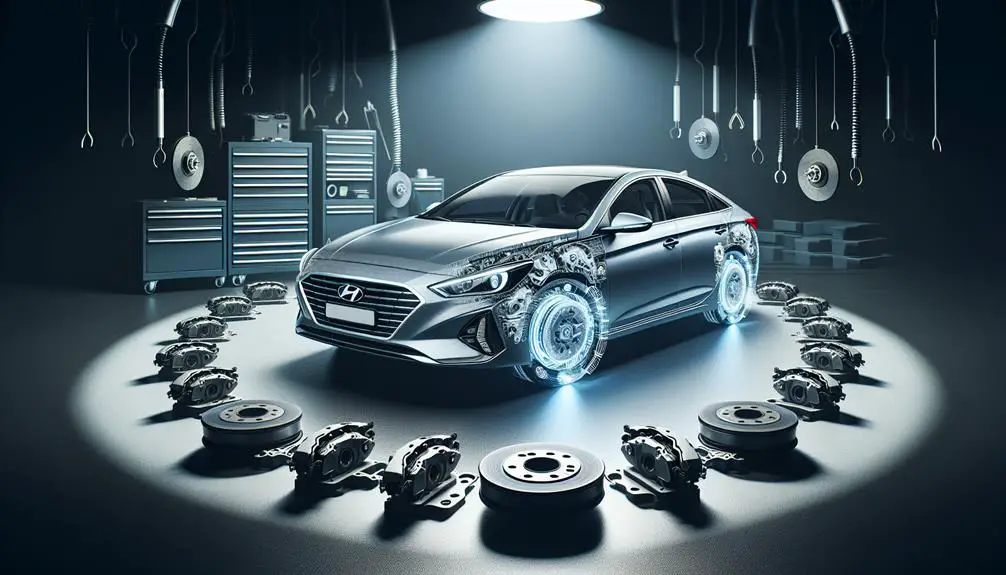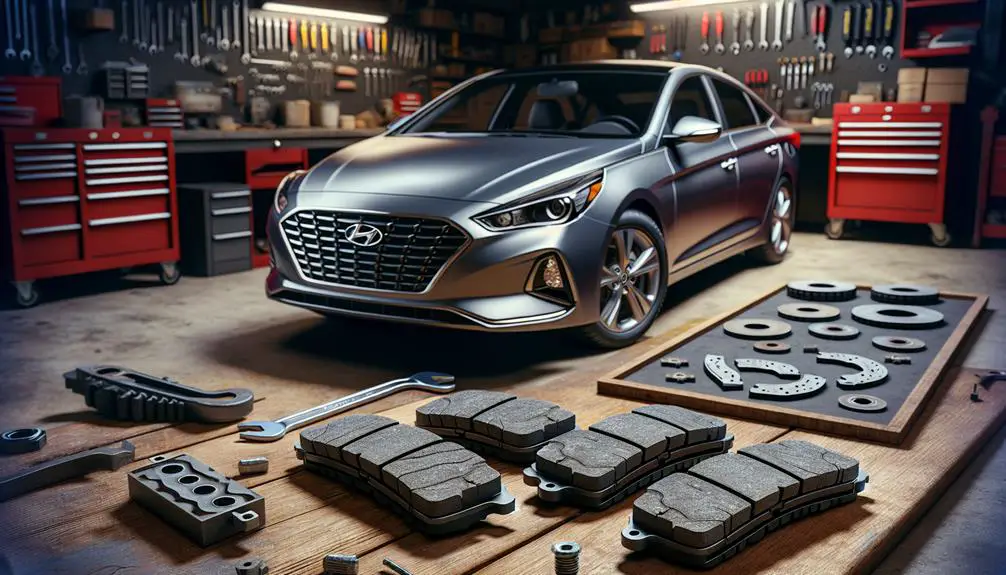A Hyundai Sonata has 8 brake pads in total, with 2 pads per wheel.
When it's time to give your Hyundai Sonata's brakes a little TLC, you might find yourself wondering about the number of brake pads tucked within its wheels. You're not alone in this quest, as the answer isn't as straightforward as you'd hope.
Each wheel houses a specific number of pads, critical for ensuring your safety and the vehicle's braking efficiency. But before you roll up your sleeves to inspect or replace them, grasping the exact count and its importance could save you time and effort.
Let's set out on this exploration together, uncovering details that might surprise you.
Understanding Brake Pads

Brake pads, essential for your car's safety, are components that, through friction, slow down your vehicle when you press the brake pedal. They're a critical part of your car's braking system, sitting snugly against the brake rotors. When you hit the brake, hydraulic fluid forces the pads against the rotors, creating the necessary friction to bring your vehicle to a stop.
You might wonder why this matters to you. Well, understanding brake pads is important because they're wear items. This means they gradually wear down over time and require replacement to maintain your car's safety and braking efficiency. Knowing a bit about them helps you recognize when it's time for a service, potentially saving you from a future accident caused by worn-out brake pads.
Brake pads come in a variety of materials, including organic, metallic, and ceramic, each with its pros and cons. Organic pads, made from a mixture of fibers, are quieter and less harsh on brake discs but wear out faster. Metallic pads, a blend of metals, offer better performance but can be noisy and may wear down rotors quicker. Ceramic pads, made from ceramic fibers, provide a great balance between durability, performance, and noise level, making them a popular choice for many drivers.
It's important to note that brake pads don't wear out at the same rate. Your driving habits, the environment you drive in, and the type of car you have all influence how quickly they degrade. Regular checks are crucial to catch any issues early and ensure your car remains safe to drive.
Counting Sonata's Brake Pads
You might be curious to know that a Hyundai Sonata typically has eight brake pads in total, with two pads per wheel making sure your vehicle stops safely and efficiently. This is a standard setup for most modern vehicles, allowing for balanced braking and best safety. Each brake pad plays a vital role in your car's braking system, pressing against the brake discs to slow down or stop your car.
Comprehending how many brake pads your Sonata has is important for maintenance and safety. Regular checks make sure they're in good condition, leading to a safer driving experience. Remember, while the number of brake pads is standard, their lifespan can vary based on driving habits and conditions.
Here's a simple breakdown to help visualize the brake pad setup in a Hyundai Sonata:
| Wheel Position | Number of Brake Pads |
|---|---|
| Front Left | 2 |
| Front Right | 2 |
| Rear Left | 2 |
| Rear Right | 2 |
This table emphasizes the uniform distribution of brake pads across all wheels, highlighting the car's design for balanced braking. Each pair works together to make sure that your Sonata can stop effectively, whether you're in heavy traffic or cruising on the highway.
Signs of Wear

Knowing when your Hyundai Sonata's brake pads are wearing down is critical to maintaining your vehicle's safety and performance. It's not just about avoiding the stress of last-minute repairs; it's about ensuring you're always in control when you're on the road.
Here are the tell-tale signs that your brake pads are due for a check or likely need replacing:
- Squealing or Screeching Noises: If you hear a high-pitched noise that stops when you apply the brakes, it's a clear indicator that your brake pads are worn out. Most brake pads have a metal wear indicator that creates this noise as a warning sign.
- Reduced Braking Performance: If your Sonata takes longer to stop than usual, or if the brake pedal feels 'spongy,' it's a sign that your brake pads might be worn down. This can significantly affect your vehicle's safety, so it's imperative to address it promptly.
- Vibration When Braking: Feeling a vibration or pulsating sensation through the brake pedal or steering wheel when you apply the brakes is often a symptom of uneven wear on your brake pads. This uneven wear can cause the rotors to warp, leading to further complications.
- Visual Check: If you're comfortable doing so, visually inspect your brake pads through the wheel's spokes. The pad should be at least 1/4 inch thick. If it looks thinner than that, it's time for a replacement.
Don't overlook these signs. Ensuring your brake pads are in good condition is essential for your safety and can save you from more costly repairs down the line.
Replacement Guidelines
When it's time to replace your Hyundai Sonata's brake pads, following specific guidelines guarantees the job's done right and your vehicle remains safe on the road. Initially, you'll need to determine the type of brake pads your Sonata requires. There are several types available, including ceramic, semi-metallic, and organic. Each has its advantages and is suited to different driving conditions. Your owner's manual will recommend the best type for your model.
Once you've selected the right brake pads, make sure you're replacing them in pairs. This means if you're changing the front left brake pad, you should also change the front right. This ensures balanced braking and prevents uneven wear, which can lead to steering issues.
Before starting the replacement, it's important to have all the necessary tools on hand. Typically, you'll need a jack and jack stands, a lug wrench, and the appropriate tools to remove the caliper and push back the piston. If you're not comfortable doing this yourself, don't hesitate to take your Sonata to a professional. Doing it wrong can compromise your vehicle's safety.
Maintenance Tips

After ensuring the correct installation of your Hyundai Sonata's brake pads, regular maintenance is key to extending their lifespan and keeping your brakes in top condition. You've made the investment in quality brake pads; now, it's important to follow through with consistent care. Here's how you can maintain your brake system effectively:
- Check Your Brake Pads Regularly: At least once every six months, take a look at your brake pads to gauge their thickness. If they're less than 1/4 inch thick (about 6.4 mm), it's time to to consider replacing them. Don't wait until you hear that tell-tale screeching sound, as this indicates that they're already overly worn.
- Listen for Unusual Noises: Besides visual inspections, keep an ear out for any unusual noises when braking. Grinding, squeaking, or screeching sounds can all point to brake pad issues or other problems within the brake system.
- Keep Brake Fluid in Check: Your brake fluid plays a pivotal role in your braking system. Ensure it's at the correct level and hasn't degraded over time. If it looks dark or dirty, it's time for a flush and replacement.
- Avoid Heavy Braking When Possible: Frequent, heavy braking can cause your brake pads to wear out more quickly. When it's safe to do so, try to brake gently and gradually. This habit not only extends the life of your brake pads but contributes to safer driving practices.
Conclusion
In wrapping up, your Hyundai Sonata has four brake pads, one for each wheel, ensuring your rides are safe.
Keep an eye out for wear signs like screeching noises or longer stopping distances. Stick to the replacement guidelines, typically every 50,000 miles, but remember, it varies based on your driving habits.
Regular maintenance checks are your best bet to keep those pads in top shape. Safe driving starts with taking care of your Sonata's brakes.